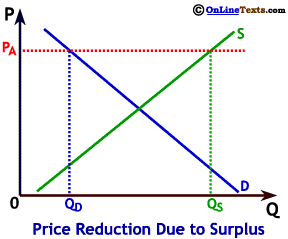
As we saw on the previous graph, when the market price is above the equilibrium price there will be a surplus of the good. The presence of this surplus will cause the market price to drop toward the equilibrium price. This process should continue until the market price reaches the equilibrium price and the market clears. We illustrate this downward movement to the right. As the price falls toward PE, the equilibrium price, the size of the surplus shrinks until both desired quantity demanded and desired quantity supplied are QE and the surplus vanishes.
That's all well and good, but how and why does this happen? Who decides to change the market price and how is that information transmitted to the various sellers? Fortunately, no one needs to coordinate this process. Retailers observe that the product isn't selling, so they either return it to the manufacturer, or they reduce the retail price, possibly selling at a loss. If they don't lower the price enough, they still can't sell all of their stock. Producers observe that retailers aren't reordering, or worse, that they are asking about return policies. This signals manufactures to lower the price they charge retailers, which in turn allows retailers to lower retail price. No coordinating authority is needed for this process. The market provides feedback in the form of slow sales and growing inventories whenever the price is above the equilibrium.

